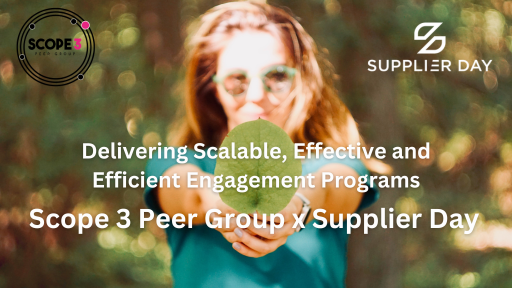Industry has moved beyond simply engaging and educating suppliers as a prerequisite for reaching carbon emissions targets required by 2025.
Leading climate scientists provide globally understood sustainable obligations which are becoming increasingly mandated and necessary.
Consequently while, universally, manufacturers’ goals may be aligned, communication and engagement with suppliers needs to be equally in sync throughout the industry – to as wide an audience as possible, as effectively as possible and as efficiently as possible.
On the 28th September Supplier Day’s CEO, Caitlyn Lewis hosted a panel discussion with Oliver Hurrey (Founder and Chair of the Scope 3 Peer Group), Robert Williams (Director of Sustainability in AstraZeneca’s Procurement team) and Alyssa Caddle (Director of Procurement Sustainability at Thermo Fisher Scientific) to examine how this can be achieved.
The event was attended by CPO’s across the board.
Scope 3 Peer Group and Supplier Day:
Delivering Scalable, Effective and Efficient Engagement Programs
“Sustainability is a change journey,” Robert Williams underlined. He acknowledged that, often, sustainable procurement demands suppliers incorporate sustainability strategies they’ve never had to before. “This can be confronting, so a meaningful and relevant engagement with the decision-makers is a necessity.”
AstraZeneca hosted their first Supplier Day in April 2022 and invited just under 1000 suppliers. Next month, another supplier day will go ahead – this time with 3 500 suppliers. Why? “Because we need to hit the majority of supply chain spend,” says Robert.
How do we decide who should be invited?
Deciding on who to invite to an event is based simply on spend and while this might not be perfect data, “we can’t let perfection be the enemy of progress,” believes Robert. Understanding where the greatest engagement is helps to incorporate as many suppliers as possible with a clear communication of requirements at the same time.
Similar to AstraZeneca, Thermo Fisher turned to the Paris Agreement as their starting block for their supply chain involvement, using spend to see where the most engagement was. “We took publicly available data to pair with spending and categorisation. We also applied information that we know about supplier sustainable maturity – which supplier is engaged and managing in comparison to those struggling to start,” explained Alyssa Caddle.
“Key to our selection was deciding the suppliers who were important to the organisation but who didn’t know how to get started on their sustainability journey.” Companies with a high spend but with little or no record of climate target were scrutinised. This directed content of the event, focussing on the basics and helping suppliers understand requirements from their own knowledge base.
There is always opportunity, after general knowledge has been disseminated, for the event to become more granular, segmenting into different areas with more bespoke presentations relevant for each supplier, Alyssa added.
How do we measure success?
Caitlyn reiterated the underpinning message: “We’ve got to get started!” However, it is equally important that the communication at supplier days needs to be effective and relevant for the audiences. Alyssa’s point about future events being more granular means that refining the information is key. As Oliver observed, supplier fatigue is real and it is vital that any engagement should be meaningful and pertinent. “We need to get started, but we need to do it well.”
So, what does it look like when you are actively engaging with suppliers?
Oliver agreed that the empirical success and effectiveness of any event is extremely important. But, he emphasised, while measurability is foundational, the emphasis is shifting to a more future-focused roadmap: it is the outcome from the initial engagement, the involvement from all who are present that is now the key to successful events. “Increasingly, success looks at the end of the event – how many suppliers came to us with ideas, solutions and examples – That’s what is important now.”
In other words, quality rather than quantity is essential. When suppliers have been informed, through a supplier day, of the requirements of the organisation, they can be called to action. Successful engagement allows for suppliers to come up with solutions and innovations that match the requirements of the company.
Events should be seen more as programmes, believes Caitlyn, as the event day itself is purely a catalyst for action. Much more comes as a result of the day – it is not a static entity.
Supplier Day’s model of “Think; Feel; Act”, incorporates the basics of a successful event:
- thinking what the goals are and how the hearts and minds of the attendees can be engaged;
- when attendees buy into the strategies proposed and become emotionally bought into the changes that are proposed,
- they share the passion which inevitably leads to action from all involved.
Thermo Fisher spent many months before their event trialling methodologies so they had a baseline idea of where the proposed attendees were in terms of their sustainability journey. This meant the organisation knew what the suppliers’ information needs were.
Within the event, which involved 150 suppliers, information was refined and segmented, narrowed down into prioritised groups. “Now we continue to refine that segmentation –we’re getting pragmatic and technical about how we follow up. This hinges on continued engagement, asking: ‘What can you commit to and on what timeline?’
Our intention is to build a better forecast around science-based target setting which we can feed back to procurement for their future decision making.”
As Robert pointed out at the beginning of the event, sustainability is becoming increasingly regulated and imposed by leading scientists and governments. Caitlyn wondered if this increased focus on sustainability could be potentially challenging for companies?
AstraZeneca has been able to act together with their peers as part of the Pharmaceutical Supply Chain Initiative and the Sustainable Market Initiative (SMI). This has enabled collective CEO’s to come together with common, aligned targets they all expect from their shared suppliers, enabling suppliers to work faster while also supporting Procurement engagement with suppliers.
Robert noted that a number of suppliers have come forward indicating their willingness to buy into the shared values. “There is great intent right across the pharmaceutical field.”
Hear more about AstraZeneca’s involvement in these initiatives here.
Beyond Events: The Everyday
And what about the mechanisms that should be in place to connect with suppliers continuously while having the flexibility to adjust when needed? “We need to have sustainability worked into every type of interaction so that it seeps into all aspects of our business,” Oliver emphasised.
Thermo Fisher ran an event last year to introduce the Climate Fit programme for lower climate maturity suppliers. “We didn’t have to recreate anything, but simply made it available as a set of tools. We regard our relationship with our small businesses as very important and want to nurture this,” Alyssa explained.
“We do ask for data but this comes with training to help: our attitude is not just ‘fill out this form’. We want to maximise and then manage the programme; to measure, report, set production targets and then do the reductions.”
The bottom line then is: Do the Reductions!
The ultimate measure of success of any event will be knowing the information is getting into the right hands. There is no doubt that the volume of attendees at events is growing exponentially, but how do programmes grow and adapt to accommodate this growing number of suppliers?
The key word, as always, is ENGAGEMENT and finding different ways to do this. Obviously, starting with a common approach is the beginning.
- Learning with suppliers allows for understanding there are different ways to engage.
- A differentiated approach that builds on the maturity on the company allows for different levels of relevant information to be targeted.
- While some companies may need help to understand basic targets, others are further along that line which allows for innovative conversations.
Sustainability is a fantastic opportunity, Robert encouraged. Industry is entirely changing and those who grasp the prospects will go long into the future.
Until now, most conversations have focused on encouraging and informing suppliers. But, will there come a time when organisations will have to make difficult decisions about retaining suppliers who are not fulfilling targets? How will businesses go about enforcing requirements?
There is no doubt that, as we move towards 2027, there will be much less room for a grey area: “Things will need to be real”, stated Alyssa and illustrated a roadmap she uses:
- Base line
- Engagement to educate
- Drive supplier action
- Go/no go
Hear more about Delivering Scalable, Effective & Efficient Supplier Engagement Programs here.
Robert conceded that ultimately some suppliers will not get the message and organisations will face situations where the decision to drop a supplier will be necessary. However, Oliver cautioned about the joint responsibility of training and nurturing that should be taken into account. “Whose responsibility is it to train and coach, if these are our targets?” We need to make sure that along with our supplier engagement, we help build supplier capability.
Robert agreed that suppliers could not be expected to be experts in sustainability. He sees his role at AstraZeneca as key in bridging the gap between the expertise of the Sustainability Team and Procurement. “We are the connection between sustainability and procurement: bringing the two communities together; translating sustainable language into the language of procurement.”
What happens next?
Alyssa was brief: “We need to get actionable and then hold ourselves to account.”
Thermo Fisher are now in the position of having a workable strategy and several groups of levers – including events, data collections, contracting, training teams. “The task now is to work out what we do in the next 18 months.” Part of this will be engaging with the communities developed through the work groups and facing them with the questions: What is your target; what is your progress?
AstraZeneca are on the same path. Progress means turning engagement into action and embedding. “We need to identify the leaders (in supply chains) and work with them in the years to come, while remembering to be open to challenges as we might also be asked to face.”
There is no doubt that the way forward is challenging and exciting. There are many opportunities for innovation and creativity that have the possibility of arising from engaging effectively with all involved in the chain.
The message is clear though:
- Act now!
- Start wherever you can – don’t let perfection be the enemy.
- Allow sustainability to be embedded through every tier of the organisation.
- Be open to challenges.
- Hold everyone – including ourselves – accountable.



